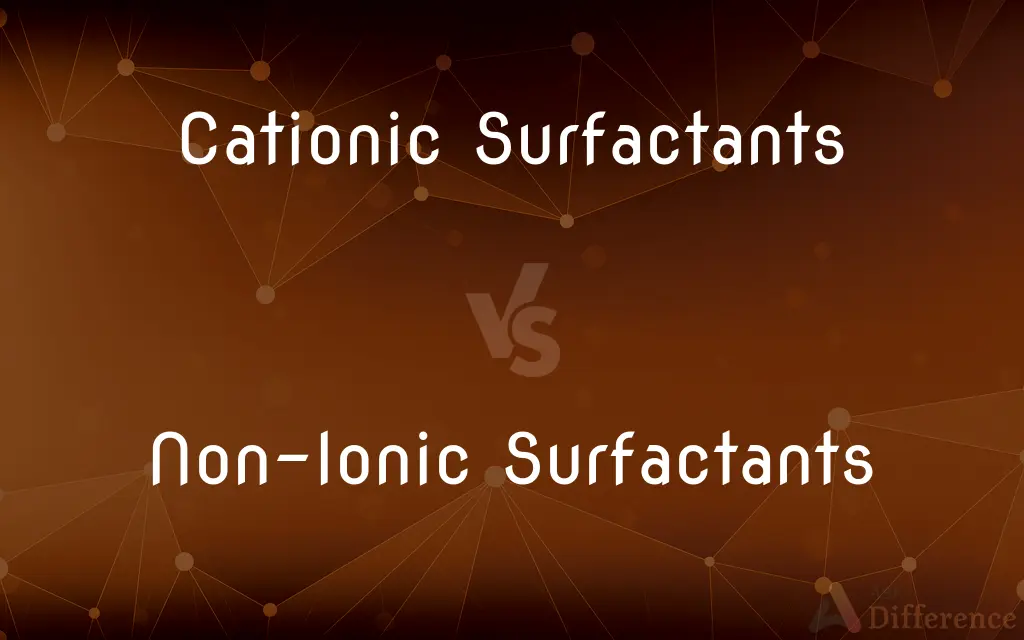Cationic Surfactants vs. Non-Ionic Surfactants — What's the Difference?
By Urooj Arif & Maham Liaqat — Published on February 20, 2024
Cationic surfactants carry a positive charge, making them effective for fabric softeners and antimicrobial agents. Non-ionic surfactants have no charge, offering stability over a wide pH range and are commonly used in detergents and cleaners.

Difference Between Cationic Surfactants and Non-Ionic Surfactants
Table of Contents
ADVERTISEMENT
Key Differences
Cationic surfactants and non-ionic surfactants are two types of surfactants used in various industrial, cleaning, and personal care products. The primary difference between them lies in their ionic nature and the applications they are best suited for due to this characteristic.
Cationic surfactants, with their positively charged active groups, are particularly effective in conditions where a strong positive charge is beneficial. This makes them ideal for use in fabric softeners, where their positive charge allows them to neutralize the negative charges on fabric fibers, leading to a softer feel. Additionally, cationic surfactants have antimicrobial properties, making them useful in disinfectants and sanitizers.
Non-ionic surfactants, on the other hand, do not carry an electrical charge. This lack of charge provides them with greater stability across a wide range of pH levels, making them versatile ingredients in a variety of cleaning products, including laundry detergents, dishwashing liquids, and all-purpose cleaners. Their stability and low toxicity make non-ionic surfactants a preferred choice for products designed for sensitive skin or environments where pH fluctuations are common.
The choice between cationic and non-ionic surfactants depends on the desired properties of the final product, such as conditioning effects, cleaning efficiency, biodegradability, and tolerance to hard water. While cationic surfactants are valued for their specific benefits in fabric care and antimicrobial applications, non-ionic surfactants are appreciated for their gentleness and effectiveness in cleaning products.
Understanding the differences between cationic and non-ionic surfactants is crucial for formulating products that meet specific requirements for cleaning, conditioning, or antimicrobial activity. Each type of surfactant brings unique properties to formulations, influenced by their charge and interaction with other substances.
ADVERTISEMENT
Comparison Chart
Ionic Charge
Positive
No charge
Common Uses
Fabric softeners, hair conditioners, antimicrobial products
Detergents, skin cleansers, emulsifiers
Stability
Sensitive to pH and other ionic substances
Stable across a wide pH range
Applications
Conditioning fabrics, killing bacteria
Cleaning, reducing irritation in personal care products
Environmental Impact
Varied, some are toxic to aquatic life
Generally lower toxicity, better biodegradability
Compare with Definitions
Cationic Surfactants
Enhances softness and antimicrobial properties.
Cationic surfactants in the shampoo provide a smooth feel and prevent dandruff.
Non-Ionic Surfactants
Effective in removing oily and greasy stains.
Non-ionic surfactants excel at lifting grease from dishes.
Cationic Surfactants
Can adhere to negatively charged surfaces like hair and fabric.
Cationic surfactants attach to hair, leaving it conditioned and soft.
Non-Ionic Surfactants
Stable across different pH levels, suitable for sensitive applications.
The non-ionic surfactants in this cleanser make it safe for all skin types.
Cationic Surfactants
Positively charged surfactants used in fabric softeners.
The cationic surfactants in this fabric softener reduce static cling.
Non-Ionic Surfactants
Preferred for formulations requiring stability and low toxicity.
Non-ionic surfactants are chosen for eco-friendly cleaning products.
Cationic Surfactants
Sensitive to the presence of anionic substances.
Mixing cationic surfactants with anionic detergents can neutralize their effects.
Non-Ionic Surfactants
Common in personal care products for mild cleansing.
This baby shampoo uses non-ionic surfactants for a no-tears formula.
Cationic Surfactants
Used in disinfectants for their germicidal effects.
This disinfectant contains cationic surfactants to kill bacteria.
Non-Ionic Surfactants
Surfactants without an electrical charge, used in detergents.
Non-ionic surfactants are key ingredients in our gentle laundry detergent.
Common Curiosities
Why are non-ionic surfactants preferred in sensitive skin products?
Their mildness and lower potential for irritation make them suitable for sensitive applications.
What are cationic surfactants?
Surfactants with a positive charge, used for their conditioning and antimicrobial properties.
How do cationic surfactants work as fabric softeners?
They neutralize the negative charge on fabric fibers, reducing static and making fabrics softer.
Can cationic and non-ionic surfactants be mixed in formulations?
They can be combined, but the specific interactions and desired product properties must be considered.
What makes cationic surfactants effective antimicrobial agents?
Their positive charge disrupts the cell membranes of microbes, leading to their destruction.
What distinguishes non-ionic surfactants from others?
Their lack of charge, making them stable in various pH environments and less irritating.
Do cationic surfactants have environmental concerns?
Some can be toxic to aquatic organisms, requiring careful disposal and environmental management.
Can cationic surfactants be used in all cleaning products?
Due to their charge, they are less common in general cleaners and more used in specific products like fabric softeners.
Are non-ionic surfactants biodegradable?
Many non-ionic surfactants are designed to be more biodegradable than their ionic counterparts.
How do non-ionic surfactants enhance cleaning products?
They help solubilize oils and greases, improving cleaning efficiency without forming soap scum.
Why are non-ionic surfactants used in emulsions?
They help stabilize mixtures of oil and water, making them essential for creams and lotions.
Can cationic surfactants be used in all hair types?
Generally, yes, but formulations may vary to address specific hair needs or concerns.
Are there health risks associated with surfactants?
While most are safe, some individuals may be sensitive to specific types; non-ionic surfactants are typically less irritating.
How do non-ionic surfactants affect detergent performance in hard water?
They are less affected by hard water minerals, maintaining their cleaning effectiveness.
How are new surfactants being developed?
Research focuses on enhancing biodegradability, reducing toxicity, and improving efficacy across various applications.
Share Your Discovery

Previous Comparison
Casual vs. Smart Casual
Next Comparison
Like vs. Would LikeAuthor Spotlight
Written by
Urooj ArifUrooj is a skilled content writer at Ask Difference, known for her exceptional ability to simplify complex topics into engaging and informative content. With a passion for research and a flair for clear, concise writing, she consistently delivers articles that resonate with our diverse audience.
Co-written by
Maham Liaqat















































